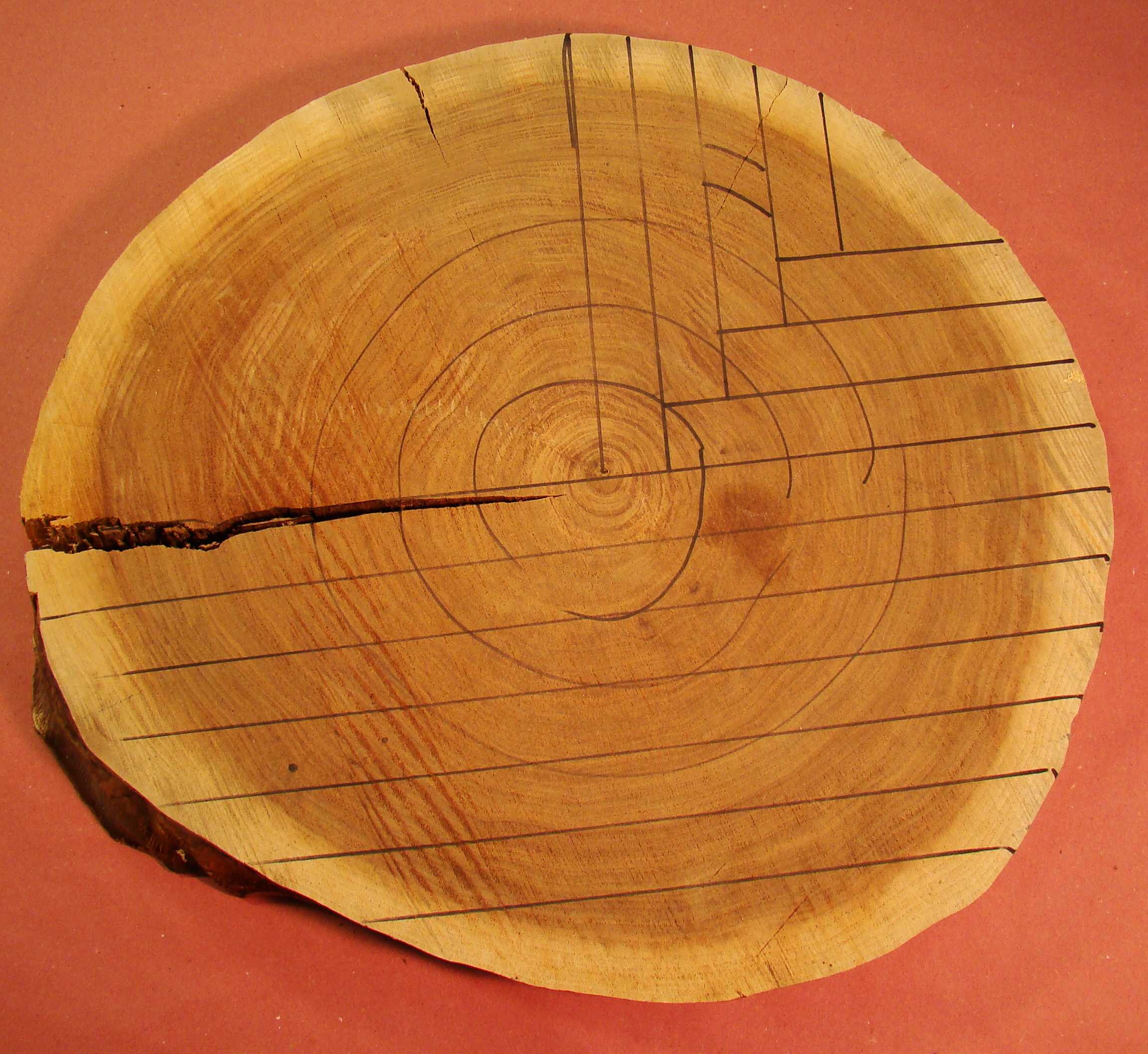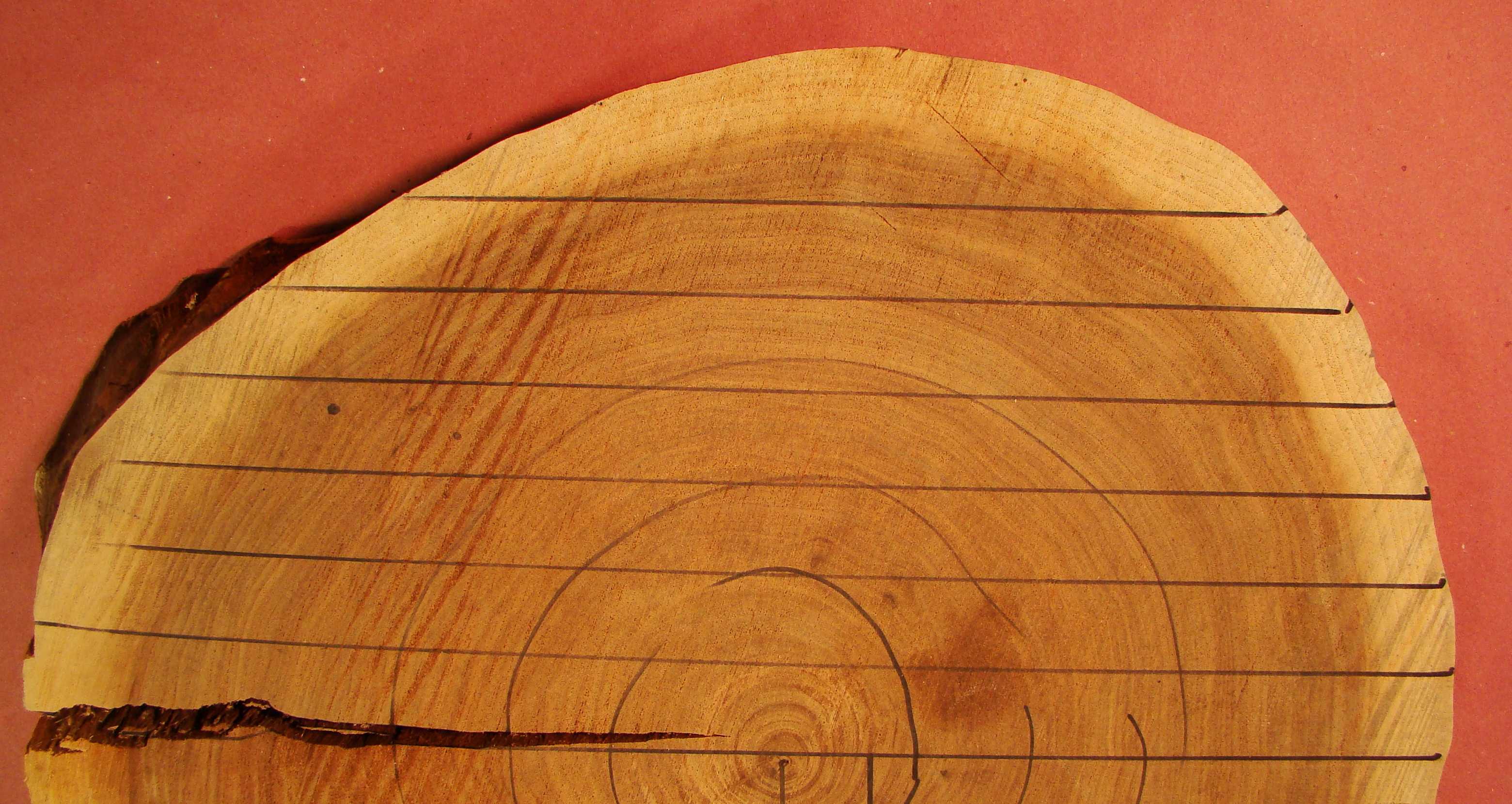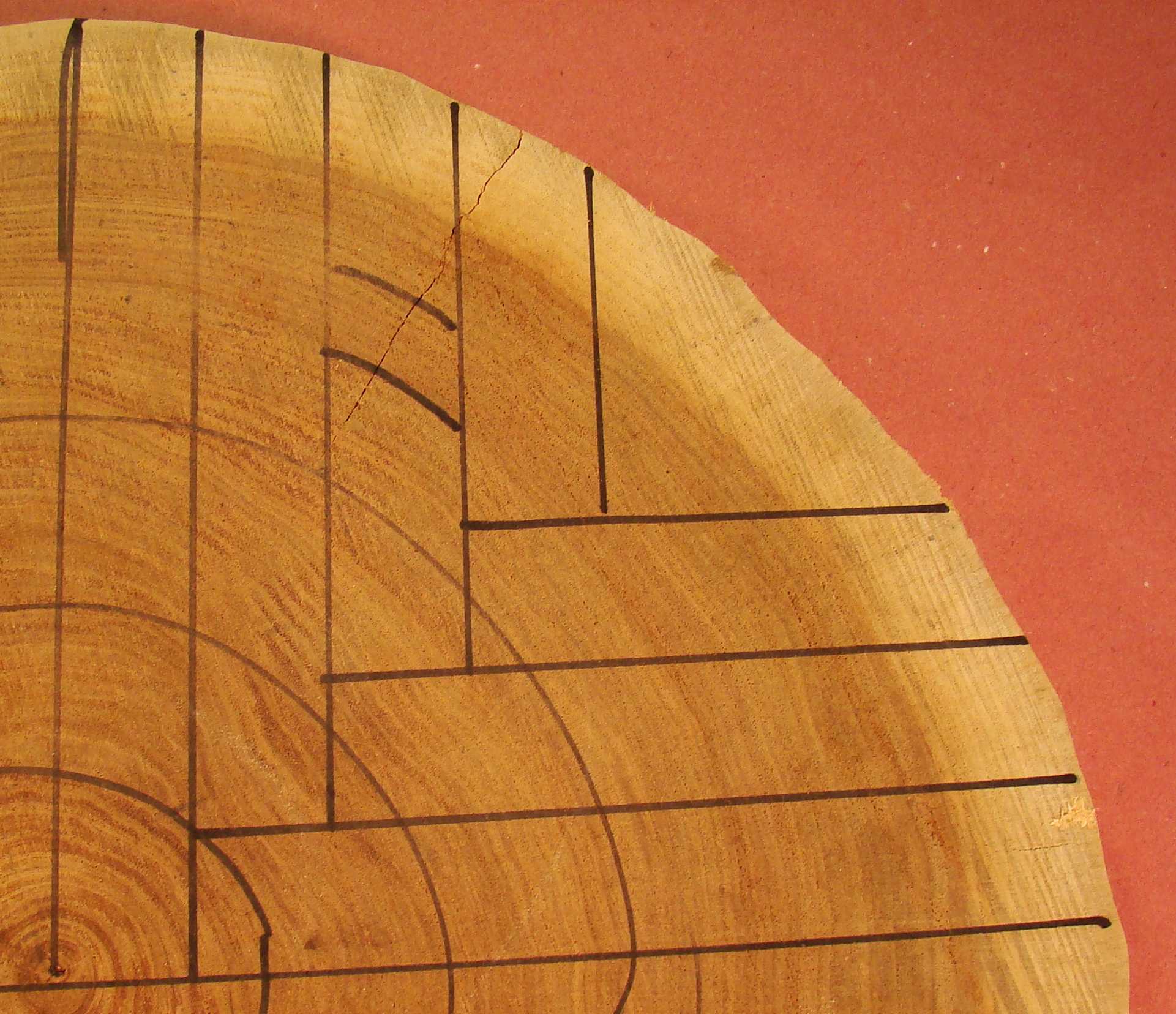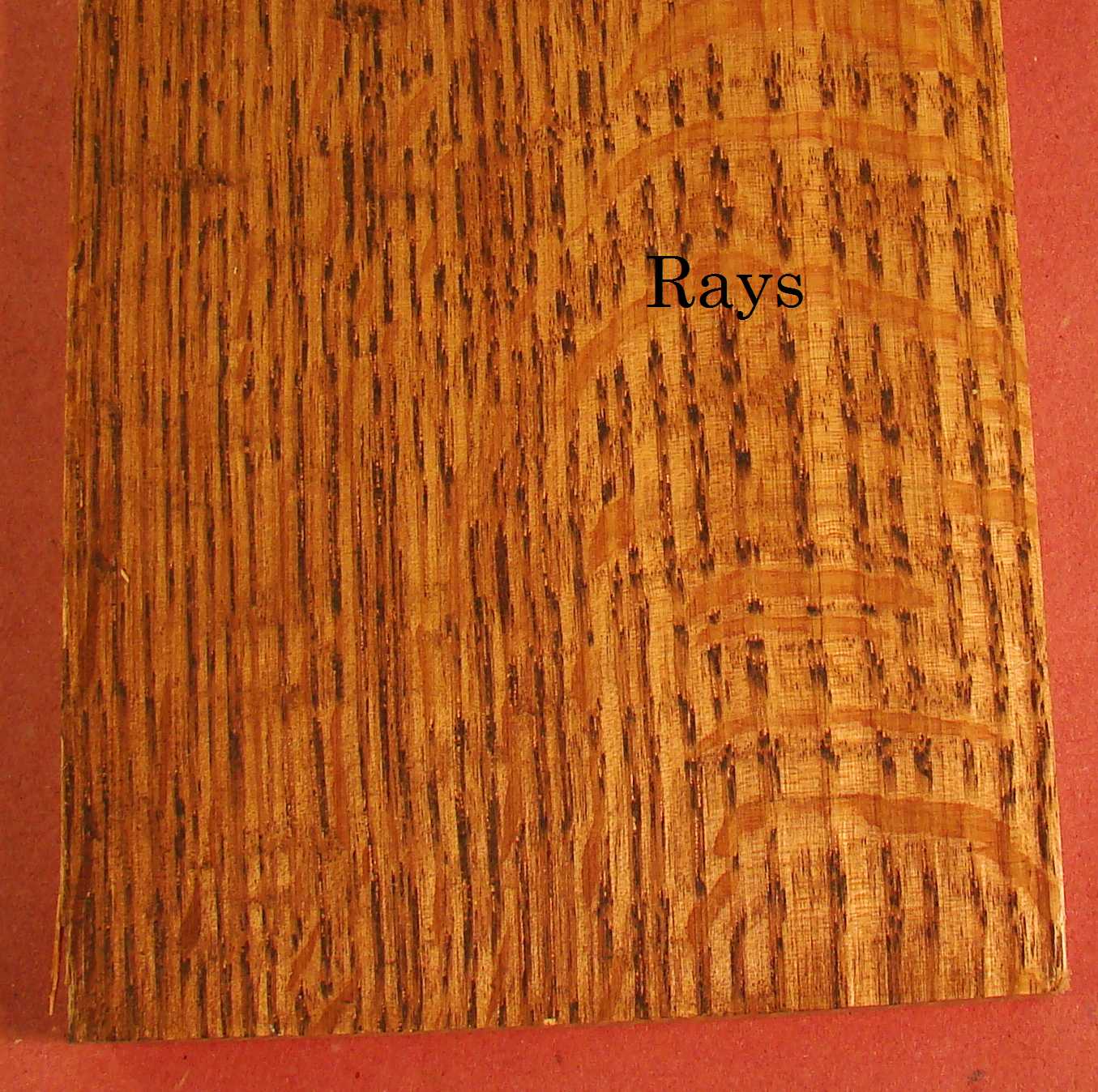Quarter-sawn wood costs about twice as much as plain-sawn. So, why use it? In order to understand the benefits (and extra cost) let’s look at how the material is milled from a tree.

Imagine this is a log ready to go through a sawmill. I’ve sketched out plain-sawn cuts on the bottom half, and quarter-sawn cuts on the top half.
 Plain-sawn, also called through and through, is pretty simple. Slabs of wood are simply cut from the log as it lays on the mill. It’s easy to see how simple this would be to set up and handle. Pay special attention to how the annual rings lay across the end grain of the resulting boards.
Plain-sawn, also called through and through, is pretty simple. Slabs of wood are simply cut from the log as it lays on the mill. It’s easy to see how simple this would be to set up and handle. Pay special attention to how the annual rings lay across the end grain of the resulting boards.
 Quarter sawing is more complicated. The log is quartered, one board is cut off the quarter, the remaining section is turned, another board is cut off, the remaining section is turned, another board is cut off — until there’s no more log left. Intuition tells us this is more complicated to execute, but look at how the annual rings lay across the end grain of the boards.
Quarter sawing is more complicated. The log is quartered, one board is cut off the quarter, the remaining section is turned, another board is cut off, the remaining section is turned, another board is cut off — until there’s no more log left. Intuition tells us this is more complicated to execute, but look at how the annual rings lay across the end grain of the boards.
Why Annual Rings Are Important
 Wood tends to cup in the direction opposing the curve of the annual rings. This board, a piece of plain-sawn wood, would tend to cup upwards.
Wood tends to cup in the direction opposing the curve of the annual rings. This board, a piece of plain-sawn wood, would tend to cup upwards.
 The annual rings in this piece of quarter sawn wood are nearly perpendicular to the face grain. The trick question is, “Which way will this board cup?” The answer is that it won’t cup. This is one of the benefits of quarter-sawn wood.
The annual rings in this piece of quarter sawn wood are nearly perpendicular to the face grain. The trick question is, “Which way will this board cup?” The answer is that it won’t cup. This is one of the benefits of quarter-sawn wood.
Annual Rings = Face Grain
What we can see in the annual rings translates into what we’ll see in the face grain.
 This piece of plain-sawn oak has a dramatic cathedral or flame pattern in the face. What you’re seeing as flames is the result of the way plain sawing slices across the annual rings. Plain-sawn wood tends to have a much more dynamic grain pattern in the face.
This piece of plain-sawn oak has a dramatic cathedral or flame pattern in the face. What you’re seeing as flames is the result of the way plain sawing slices across the annual rings. Plain-sawn wood tends to have a much more dynamic grain pattern in the face.
 The face grain of this quarter-sawn piece is very straight, thanks to the way the quarter sawing process slices through the annual rings.
The face grain of this quarter-sawn piece is very straight, thanks to the way the quarter sawing process slices through the annual rings.
Back in the day I worked at a cabinet shop where we built all the fixtures for a national retail chain. They specified quarter-sawn cherry for all their stores because they didn’t want the overly-busy look of plain-sawn cherry on all the walls and cabinets.
Then There Are The Flecks And Rays.
 When wood is quarter-sawn the internal rays of the wood are exposed. In some materials, especially red and white oak, this can be VERY dramatic, giving the finished wood an amazing three dimensional appearance. Think of the old Singer sewing machine cases. Great examples of quarter-sawn oak.
When wood is quarter-sawn the internal rays of the wood are exposed. In some materials, especially red and white oak, this can be VERY dramatic, giving the finished wood an amazing three dimensional appearance. Think of the old Singer sewing machine cases. Great examples of quarter-sawn oak.
Not all woods provide this benefit.
Three Reasons To Pony Up
Knowing that quarter-sawn wood can out price plain-sawn by a factor of two (or more), here are the compelling reasons to buy it.
- Quarter-sawn wood is more stable than plain-sawn. Not only is it less prone to cupping, it also expands and contracts less.
- Quarter-sawn provides a “quieter” and straighter face grain than plain-sawn.
- In some woods, especially the oaks, quarter sawing reveals dramatic internal rays that add a very cool dimension to the material.
It’s relatively easy to find quarter-sawn red and white oak. Other species can be much more difficult to locate in quarter-sawn, and may require a number of phone calls to track down.
Related Videos:
Your images for the description of quarter and plain sawed wood are reversed.... Pretty important details.
A fourth ( and possibly the best ) reason to use quartersawn lumber is that in the same stumpage the quarter sawn surface has about twice the elasticity rate as the flat grain surface. So quartersawn has a lower shrink rate and is more elastic giving it two aspects that make it much more effective in producing durable woodwork. I can't tell you how many people leave the elasticity part out of the equation and personally it is my belief that the elasticity aspect of quarter sawn is more essential to its effective benefit over flat sawn then shrink and expand rate are. Although both are certainly important aspects.
Can you quarter saw 2x4 or even 4x4 out of say cedar?
Perhaps your photos have been mismatched but you first describe a piece as plain sawn and then show what appears to be the same piece rotated 90º and call it quarter sawn.
The descriptions and pictures of the face grains for plain-saw and quarter-sawn are opposite of what they should be.
You have the photos of the plain-sawn and quarter-sawn oak reversed.
need to know how to cut
I have been woodworking for years and use mostly White and Red Oak. I always have my logs quarter sawn. Everything above is absolutely correct. It is worth the extra money to have your project to turn out superb!
Hi, looks like those 2 photos are still swapped. Several other readers noted the same issue in previous comments.
Love the look of quarter sawn oak!